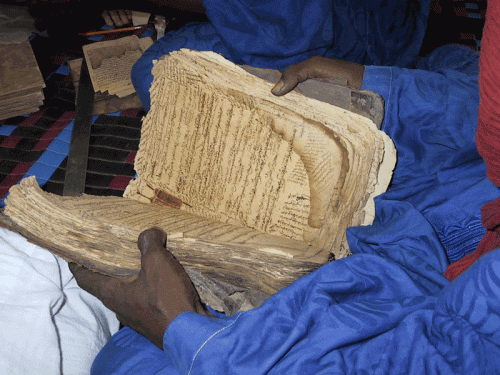Mansa Musa & the Kingdom of Mali

The Hajj of Mansa Musa
The people of Ghana were not the only group in West Africa. Another group of people ruled an area that was located along the Niger River further west of Ghana. The kingdom of Mali was small, but its leader, Sundiata, had other plans for his kingdom. In 1230 CE, Sundiata led an army against the Almoravids and conquered Ghana. Now Mali was in control of the rich trans-Saharan trade routes. Sundiata worked to improve agriculture and make his land wealthy and powerful. However, it is his grandson, Mansa Musa, who would make Mali into a legendary empire known for its wealth and knowledge.
Mansa Musa was a Muslim, which was very common in Mali by the 1200s CE. In fact, most of Mali's rulers, and at least half of the common folk, had become Muslims by this time period. Because of Mansa Musa's influence, Islam spread throughout West Africa, gaining many new believers. Mansa Musa ruled for 25 years from about 1312-1337 CE. During that time Mali used its wealth to create great centers of learning and Islamic culture. One of the most important of these cities was Timbuktu. Mansa Musa built universities, libraries, palaces, and mosques (a mosque is a Muslim place of worship), which made Timbuktu one of the most important cities in Africa during the 1300-1400s.
Mansa Musa was a very devout Muslim who took his religion seriously. One of the main duties of every Muslim is to make a religious journey, called a Hajj, to the holy city of Mecca at least once in their lifetime. In 1324, Mansa Musa set off from Mali to make the Hajj. Of course millions of people have made this journey before, but none did it in quite the same style as Mansa Musa.
Timbuktu
In the West African country of Mali is the city of Timbuktu, a town with mud brick homes that surround small private courtyards, streets covered in ankle deep dust that keeps blowing in from the Sahara, and a few scattered shops and market. This is all that remains of the city that six centuries ago was called the “Pearl of Africa”.
Back in the days when the Empire of Ghana was just getting started, the city of Timbuktu was little more than a marketplace at crossroads where the Niger River met the Sahara. Some call this location, where the camel meets the canoe. Here Turaeg caravans traveling south through the Sahara would carry their goods to meet with the African merchants of Djenne. Not being able to understand one another the two sides would participate in a silent marketplace. One observer of this unique arrangement had this to say:
“Arab and African traders brought salt from the north and upon arriving at the trading place they would spread out their goods and announce their presence by beating on a drum called a deba. They would retreat and traders bearing gold would arrive laying out amounts of gold dust next to the salt or other goods as payment and then depart. When the first group returned, if the amount of gold was sufficient they accepted it and left. If not, they would leave everything untouched and wait for more gold to be put out.”
Before long Timbuktu had become more than just a place to park your camel as merchants realized that its location at the bend of the Niger River was an ideal place to set up a permanent place to trade. Nobody is sure how Timbuktu got its name. One legend says that the Turaeg trusted their goods to a slave woman named Buktoo (tim refered to her being a slave). Another story says that the Tuareg met an old woman whom they called Tin Abutut, which translates to 'lady with the big navel', at a dry well near the river.
Whatever the story, Timbuktu slowly began to evolve into a proper town and by the days of Mansa Musa had become a bustling city. By the 1200s the city boasted of three universities and 130 Koranic schools (place of Islamic education).
When Mansa Musa returned from his famous Hajj to the holy city of Mecca he brought with him, vast quantities of books, Islamic scholars and translators, artisans, and scientists to work at the houses of learning that made the internationally renowned. Mansa Musa commissioned the famous mud brick Djinguereber Mosque. The mosque might not look like more than a mud building with sticks poking from it but in its day it was an engineering marvel. Using the clay and dirt of the natural environment was nothing new to the people of the Sahel. The arid environment meant wood was scarce. But in the flash floods that often came in the spring, mud brick buildings tended to erode. The Djinguereber Mosque used wooden beams cut from Palm trees as a skeleton and then coated the outside with mud brick which made it more durable. The Mosque has stood for more than 700 years like a witness to the city’s former glory.
At its height the medieval city of Timbuktu-with 200,000 people– was larger and wealthier than London, Paris, and Rome. More than any other person Mansa Musa established Timbuktu’s reputation as the “City of Gold”. One visitor to the city, Leo Africanus wrote:
“Here are great stores (quantities) of doctors, judges, priests, and other learned men who are bountifully maintained at the king’s cost…”. Africanus was also impressed by the hospitality of the people as well as the great centers of learning. In his diary he commented that “The inhabitants are people of a gentle and cheerful disposition…and spend a great part of the night in singing and dancing through all the streets of the city”.



Lost Libraries of Timbuktu



A page from a Koran (written in Arabic) found at the library
of Timbuktu
Test Page